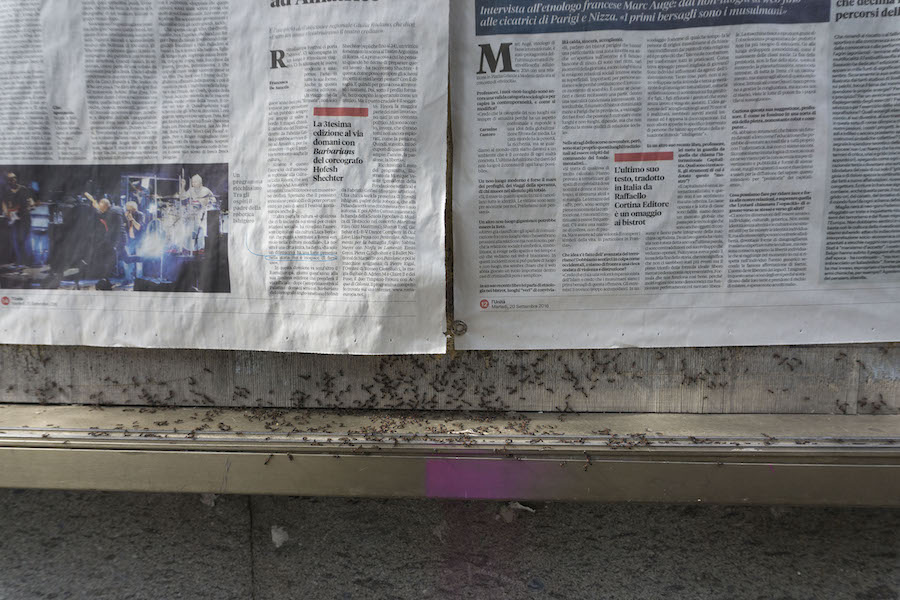Queste immagini sono alcuni appunti raccolti da Jakub Czyszczon durante la sua residenza a roma per preparare la mostra Micrograms da Ermes–Ermes, che l’artista ha selezionato per ATP diary.
Segue il testo di Micrograms che sarà visitabile nello spazio di Ermes–Ermes a Roma fino al 2 Novembre.
WALK 1
WALK 2
WALK 3
MICROGRAMS — Jakub Czyszczon
text by Jakub Bak
First look, superficially pleasant and deeply disturbing, may give rise to panic. A glance is not enough, you have to look. Slowly, gradually penetrating deeper with sight and let it free too follow the traces enshrined in subtle fragmentations of substance which are covering every painting. Faceing the paintings of Jakub Czyszczon, eyes can’t find peace, won’t capture the whole imagery, won’t recognize the motives, won’t find a convenient comparison, neither it won’t come to a synthetic judgement.
It is difficult to analyze individual decisions of the painter, in fact they have been dispersed, propagated and distributed, miniaturized and repeatedly mixed by the subtle segmentations. They are neither the result of a composition or improvisation, they do not involve long-term memory reconstruction processes, or release of short-term memory, so it is not neither remembering nor forgetting. Czyszczon?’s painting practice is a kind of carefully conducted micro-explosions which produce an image of painting matter in state of highly energy saturated movement. The painter methodically operates with the detail and the detail of detail multiplied evenly in all directions at once, both in the plan of the surface and into the successive layers of scratched paint and layered glazes. Following these micro-events with increasing intensity one can see their movement: continuous, with no beginning, direction and purpose, without a starting point and no destination.
Watching these images extends in time; it is a process that is full of discoveries and consequences that lead to further exploration that drives continual delving and becoming increasingly sophisticated in more fluent watching. The unrestrained and pointless movement of glance reveal the ultra-structure and inter-structure, edges, adhesions, membranes, nexuses, spaces, transitions, flows, stratifications, faults and estuaries. Through them seeing becomes more self-reflexive, free, sinking deeper and deeper into itself. This can be seen as a relaxing curiosity, pleasure, satisfaction filling aesthetic experience, or act of self-defense, training in the use of an effective weapon.
Attention, sight, the ability to distinct images and the time spent with them is something of a natural resource, like animals. Attention today is grown in reservations and on farms, while maintaining a semblance of free vegetation on endless pastures or in secret automated halls. Attention is extracted, mined, redirected, transferred, disciplined, listed and cashed. Economics and politics, management and control, is most efficiently realized through image and techniques of sighting. The glance is a strong currency, therefore is the object of ongoing attempts to take over, ruthless attacks made using more and more advanced technology. The industry of attention do not spare resources for development, research and attempts to create ever faster and more efficient engines of excitation, seduction and understanding of vision; directing, controlling and activating attention.
Jakub Czyszczon? builds an alternative way of perceiving, through his paintings derives sight of habit, he puts it to vibrate at a very dense frequency, breaks the rhythm and tirelessly does not allow the following gaze to rest in the comfortable satisfaction. His paintings forcefully oppose so well forced habits of seeing, destroy everything that the industry of attention management, with great success, establishes as the norm. Trained agility for instant recognization of the well-known is broken and wrecked, eyes and attention need to learn a new operating mode, reconfigure and follow in an unknown direction.
Translation by Marcin Czerkasow














